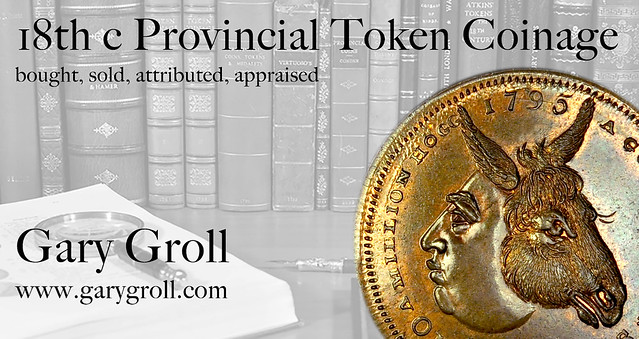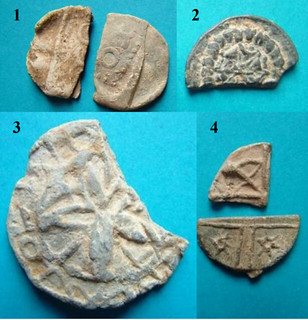
PREV ARTICLE
NEXT ARTICLE
FULL ISSUE
PREV FULL ISSUE
DELIBERATELY DAMAGED COINS AND TOKENSDavid Powell submitted these notes about articles on the topic of deliberately damaged coins and tokens. Thanks! -Editor With reference to last week's E-Sylum article on deliberately damaged Celtic coins, there are three types of British tokens which I believe were sometimes deliberately defaced:
I have written a whole article on this in edition 59 of my lead token newsletter {Leaden Tokens Telegraph, or LTT}, and there is another, on communion tokens specifically, on pages 3-4 of edition 29. The main purpose of this mutilation was as an invalidation mark, to indicate that the piece was no longer current, although in the case of communion tokens mutilations of different types were sometimes applied to the pieces of the same basic design as a form of differentiation. It is very possible that invalidation marks may have been applied to other series, including coins, after they had been declared obsolete.
Thanks! Here's an excerpt from the Damaged Communion Tokens article. -Editor In some of the Scottish churches which issued communion tokens, it was found administratively convenient to do so from a number of tables, scattered around the church, and to direct the congregation to specific tables so as to ensure an even distribution and optimum flow. The usual method of doing this was to counterstamp the token, either on the back if it was uniface, or in a space left in the main design specifically for the purpose. A minority of table-numbered pieces have the digit struck as part of the design, as per the rest of the detail, although these tend to be more in the post-1843 white metal period than in the crude lead days; one disadvantage of pre-striking being that the church was stuck with what pieces it had, and lost the advantage of being able to counterstamp selectively. One would think that it was the larger city churches which found the greater need to indulge in such practices, but it was not necessarily the case; some of what you would think were quite modest rural parishes seemed to find the need for more tables than you would have thought. The frequency of table number obviously decreases as the table number increases; the highest number observed on a token is 13, although it is on record that 29 tables were used to serve 2361 communicants on one occasion in Perthshire in 1791, and that even as early as 1725 the Methodist George Whitefield needed seventeen for one of his evangelical campaigns at Cambuslang. These latter were special events, no doubt, and this article is devoted to what was the norm in tablenumbering churches during the years, pre-1843, when lead and pewter was still dominant. The practice {usually only associated with the established Presbyterian Kirk} was in occasional use by 1690, although it remained somewhat uncommon for much of the 18th century, only increasing in frequency towards its end. Figs.1-5 illustrate a number of pieces on which the reverse contains nothing more than a counterstamp, plus sometimes the word "TABLE" or "No." above. Figs. 1,2,4 date from the 1780s, Figs.3,5 from the 1820s. 
Fig.6, from Dalry, Perthshire, is undated but likely to be one of the earliest with prestruck number, perhaps c.1735-50; having said which, no number other than "1" has been seen, which argues that it might have some other meaning. Figs.7,8 are two examples, dated 1798 and 1803, where the number is counterstruck into the obverse design; in one case into a space vacant to receive it, in the other straight over the top. Fig.9, from Huntly, Aberdeenshire, dates from 1761 and is of a type where a numeral is known on some example to the right of the parish letter; which makes sense, as why otherwise would the latter be placed off-centre? This example seems to have an insignificant mark to the right, akin to those found on crude lead type 24, but with the aid of photography a rather unconvincing "4" is hinted at. Fig.10, from Rosemarkie, Morayshire is also quite early; if, of course, that mark above the date is a "2" rather than a meaningless squiggle.

To read the complete article (page 3), see:
Here's an excerpt from the Damaged Tradesmens' Tokens article. -Editor Damaged Tradesmens' Tokens: Deliberate or Otherwise? In LTT_29 {Aug 2007} I wrote concerning the reason behind the various malformations and mutilation of lead communion tokens, suggesting that one should consider a variety of positive motives beyond mere vandalism. I do so again now in respect of tradesmens' tokens, both those in the lead and the main 17th century series; many of the reasons are applicable to both types. Damage can take a variety of forms; amongst others:
...in addition to which, deliberate holes can be of various shapes. I suggest that one of the most frequent reasons behind several of these categories is invalidation, i.e. the requirement to show that the piece is no longer valid, but let us deal with each in turn. In addition to all the above, there are defects of manufacture, particularly in the crude lead series, some of which cannot always be easily distinguished from subsequent damage.
To read the complete article (page 1), see:
To visit the Leaden Tokens Telegraph website, see:
To read the earlier E-Sylum article, see:

Wayne Homren, Editor The Numismatic Bibliomania Society is a non-profit organization promoting numismatic literature. See our web site at coinbooks.org. To submit items for publication in The E-Sylum, write to the Editor at this address: whomren@gmail.com To subscribe go to: https://my.binhost.com/lists/listinfo/esylum All Rights Reserved. NBS Home Page Contact the NBS webmaster 
|
